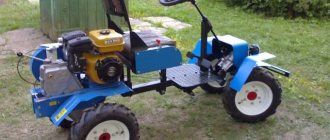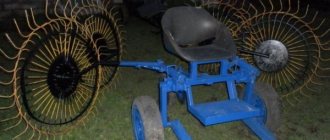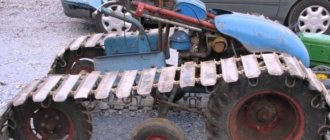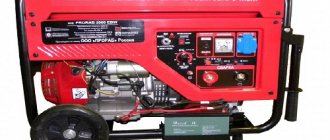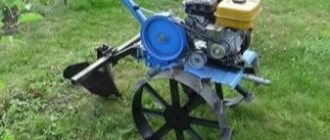Factory and homemade hydraulics for a motor tractor
Despite their small dimensions, modern mini tractors allow their owners to cope with very labor-intensive work. Starting from plowing the soil and ending with transporting crops, firewood, coal, and various cargoes. The equipment is used not only in the agricultural sector, but also in public utilities and construction. The key to this expansion of the functionality of the unit is special attachments and a reliable hydraulic system. It will reduce labor costs and significantly simplify pressing agricultural tasks through the use of a wide range of mounted implements (dozer blades, buckets, seeders, tedders, tedders). In addition, the operation of the minitractor’s hydraulics directly affects more convenient control of the agricultural machine:
- provides easy steering;
- simple wheel control (when placed near the drive wheels);
- the vehicle can turn around almost on the spot;
- guarantees quick stopping of the tractor (if there is a hydraulic brake).
However, before connecting the hydraulic cylinder and the factory PTO, it is worth considering. Most of the engine power will be spent on the functioning of these components and the tractor will not be able to reach maximum speed.
DIY hydraulics for a mini tractor
The question “How to make hydraulics for a mini tractor with your own hands?” occurs among many owners of agricultural machinery. After all, factory equipment is quite expensive. Another reason to think about homemade products was the availability of information and parts for assembling each individual unit.
By creating a manually controlled hydraulic valve yourself, owners of special equipment will receive several advantages:
- possibility of using additional attachments;
- improvement of the braking system;
- simplified control of the unit.
The adjustment of all components and parts is carried out for a specific person, who will manage the work process. And this will make the tractor more convenient and comfortable to operate.
To assemble hydraulics yourself, you will need a competent diagram and a number of spare parts. First of all, you need a good oil pump that will act on the hydraulic motors. The hydraulic elements are mounted on the metal frame of the mini-tractor, as close as possible to the drive axle. You will also need a distribution element to change the direction of rotation, a set of hoses, a reservoir and a spool for oil drainage. When assembling, you should consider several nuances:
- the hydraulic pump for the minitractor is located directly above the tank (free oil supply, quick start);
- it is necessary to calculate the power of all tractor mechanisms (perhaps for greater productivity you will need a two-section hydraulic pump, which guarantees uninterrupted operation of the mechanism even under significant loads);
- The installation of cleaning oil filters will extend the service life of the system.
After purchasing the necessary parts and careful calculations, you can begin assembling the unit, calibrating the parts and checking the tightness of the connections, the cleanliness of the hoses, and the functioning of the hydraulics.
Side-swivel baby with hydraulic drive
A topic by a portal user with the nickname RoteRatte about how he made a universal flat-rotating hydraulic platform on wheels caught the attention of many. Of course, the “baby” in the photo below is capable of a lot.
Lift and transport FBS blocks weighing 200 and 500 kg.
Remove the fertile soil layer from the area.
Use a bucket to clear snow on roads in SNT in winter.
Moreover, as various attachments are manufactured, the range of tasks that a mini-tractor loader can solve will expand significantly.
About a year ago I took up the task of landscaping my site. There were a lot of things to do - level the site, pull out the old FBS blocks on which the old house stood, uproot stumps, etc. I was thinking about ordering a small-sized tractor to remove the topsoil, but the price tag for working on two sites with a total area of about 250 sq. m. I was charged 30 thousand rubles. Moreover, the “firms” also fed me with promises for 2 weeks. So I thought and thought and made a mini tractor, and then completed this job in 2 days.
From the idea to the implementation of the mini tractor in metal, it took RoteRatte about 7 months. The key to success is careful calculation, planning, as well as the maximum use of ready-made factory components and parts from automotive equipment.
After developing the concept of the device, the user ordered and purchased units that you can simply put at home and not think that their prices will rise. These are the engine (“390th” Champion with an electric starter, 13 hp), hydraulics (hydraulic pumps, hydraulic cylinders), drives and wheels.
Rolled metal was left for later. RoteRatte also thought out the layout of the mini tractor in such a way as to minimize turning work.
Of the main tools RoteRatte used:
- angle grinder (angle grinder);
- household welding inverter;
- simple drilling machine;
- drill;
- hammer.
Main technical characteristics of the mini tractor:
- length – 2050 mm;
- width – 1100 mm;
- height – 1400 mm;
- speed – 3-4 km/h;
- weight – 400 kg.
Although the user calculated various parameters of the hydraulic system and drives on special calculators, the “baby” turned out to be stronger than intended. For example, a mini tractor can easily lift and drag concrete foundation blocks weighing 200 kg.
How do hydraulics work?
The hydraulic system is a complex set of built-in mechanisms designed to receive and transform the energy of the internal combustion engine with its further transfer to the working parts of special equipment. The hydraulic system gives the tractor operator the ability to control trailed and mounted agricultural implements, as well as regulate their operation: change the lift of the frame, adjust the appropriate rut depth.
The principle of operation of hydraulics on a tractor is based on the continuous circulation of fluid - it is this fluid that is responsible for converting the energy created by the motor into the force necessary for the stable operation of the installed equipment. In both old and modern tractors, the role of this fluid is played by hydraulic oil.
Structurally, the hydraulics on a tractor consists of the following components:
- oil reservoir;
- a filter that protects the system from foreign components entering it. Thus, the filter element prevents accelerated wear of the entire system;
- a system of pipes through which oil continuously circulates under pressure;
- a pump equipped with a drive and a built-in activation mechanism. When assembled, this unit is designed to create pressure in the tractor hydraulics, which is necessary for the movement of oil and the operation of attachments;
- distributor - the function of this unit is to direct the working fluid to the built-in final mechanism, the role of which is played by the power cylinder or hydraulic motor of the trailed implement used. The distributor constantly monitors the operation of all hydraulics and, if necessary, switches it to idle mode. If there is an increased load on the system, the distributor reduces the pressure inside it, thereby preventing the system from overheating;
- The cylinder is the final assembly that receives oil from the distributor. It is the cylinder that is responsible for lowering and raising the attachment used;
- motor – connected to the wheels.
In addition, the hydraulic structure includes valves, shut-off couplings, bends and coolers.
Functions and features of hydraulic oil tank
A hydraulic tank for a station or any vehicle is simply necessary, because it stores the working fluid - the power and driving force of hydraulic installations. In addition to directly storing the liquid medium, the container performs the following functions:
The hydraulic tank of an excavator, tractor or any other special equipment is offered in various models, which differ in size, capacity, shape, installation location, and manufacturer. When choosing a node, consider:
Equipment and arrangement of oil tanks
The hydraulic tank of a tractor or truck is a sealed container made of durable and thin sheet of steel and aluminum. Externally, the tank is smooth or ribbed, which improves heat transfer. Inside, the product has a partition that divides the space into a drain and suction section. The conical bottom serves as a collection point for sludge, which is removed from the container through a special pipe. The filler neck is equipped with a mesh filter, and its cap is equipped with a breather. Tightness is ensured by rubber gaskets.
The tank uses a turbocharged engine, pumping pressure, which is maintained at the required level by a check valve. The pressure pushes the liquid into the suction line, where it is captured by the pump and driven through the hydraulic lines. Having made a circle, the oil is returned to the container, cooled, cleaned and goes on to the next cycle.
The design of oil tanks from different manufacturers can vary greatly, and their equipment also varies. On sale you can find the container itself or a complete kit ready for connection. It includes:
The configuration affects the cost of the product and determines the features of its installation.
Source
Tractor hydraulic oil
For stable operation, the tractor hydraulic system requires high-quality working fluid. Oils for filling hydraulics can be of three types: low-, medium-viscosity and viscous. The first group includes liquids of the MGE-4A and MGE-10A brands. MGE-4A oil is distinguished by a light fraction that has undergone multi-level purification. This oil contains additives that accelerate its thickening, as well as inhibitors that protect hydraulic system parts from oxidation and rust formation. In addition, MGE-4A oil has good resistance to low temperatures.
Necessary tools
Each specific case may require its own set of tools and materials required for assembly. Their main set:
The list can be supplemented with items depending on the assembly conditions.
Required parts:
The main components are shown in the photo.
How to make hydraulics for a homemade tractor?
Despite the complexity of the device, hydraulics for the tractor can be made independently. To do this, the operator will need to be as careful as possible, since for the coordinated operation of the assembled mechanism, it is necessary to make accurate calculations and act strictly according to them.
A homemade mechanism gives the tractor driver important advantages:
- the ability to operate additional attachments, including a trailer;
- improving the braking characteristics of the tractor;
- increased handling both on smooth roads and off-road;
- individual components and the general hydraulic structure can be adjusted in a way that is convenient for use by a specific person.
All this will make the practical use of agricultural machinery with hydraulics not only convenient, but also more efficient, regardless of the work being performed.
To assemble the hydraulic system on a tractor yourself, it is important to adhere to the drawings. They need to describe not only the dimensions and characteristics of the components, but also the sequence of their installation.
In the future, tractor hydraulics should be assembled in the following sequence:
- First you need to make a strong frame. All hydraulic elements will be attached to the supporting structure. To ensure minimal loads are applied to the frame, the nodes used must be installed as close to the axial center as possible. This will improve balancing and reduce vibration on the supporting structure;
- After this, you need to secure the hydraulic oil reservoir. If it is plastic, then it can be fixed with clamps. If the tank is metal, then it is better to weld it to the frame;
- Next you will need to install the oil pump. It should be located above the tank. This way the pump will have free access to the working fluid and will be able to ensure a stable start of the entire system;
- During the manufacture of a hydraulic system for a tractor, it is necessary to correctly calculate its performance. Thus, the manufacturer will understand whether it is necessary to install a more productive 2-section pump;
- After installing the pump, you need to secure the filter elements. There should be several of them - at the outlet of the oil reservoir and at the point where the fluid is supplied to the cylinders. The more filters, the more difficult it is to maintain the hydraulics. However, with an increase in their number, the service life of the homemade system will increase;
- At the end, you will need to stretch tubes between the hydraulic units. They must be made of a material that is resistant to oil components. It is best to choose tubes made of technical rubber. The tubes must be secured to the outputs and inputs using clamps. You can learn more about making hydraulics for a tractor in the video.
After assembly, the finished hydraulics will need to be tested. To do this, you need to install a small implement on the tractor, connect it to the system and start the tractor engine. Then you need to start the homemade hydraulics, allowing the pump to pump a small amount of oil. After about 15–20 minutes of operation in light mode, you can move on to more intensive use of the mechanism.
Hydraulic design of a mini tractor
Homemade hydraulics are a good way to expand the functionality of a mini tractor and save a significant amount. The assembly and installation of such a structure cannot be called something very complicated. If you have the necessary parts and tools, every farmer who wants to can make this mechanism.
The main element of any hydraulic system is the pump, which is responsible for circulating fluid through the hoses. Oil flows to the pump from the reservoir. The pumping mechanism itself operates from the energy generated by the diesel engine of the mini tractor. Under the action of the pump, the oil flows through flexible tubes to the distributor. To make hydraulics for an agricultural machine, you can use an NSh-10 pump.
Making a hydraulic distributor with your own hands is quite difficult, so the best solution would be to dismantle a ready-made unit from any old tractor. A distributor of the P-80 brand, which is equipped with MTZ tractors, will be suitable for installation on a homemade machine.
Through the distributor, the oil enters the cylinder, the main function of which is to raise and lower attachments. Ready-made homemade hydraulics should be installed on the frame of a homemade machine, closer to its drive axle.
The system can also be supplemented with motors that must be connected to the wheels. Thus, hydraulics will not only lift the attachments, but also participate in braking the mini tractor.
When such hydraulics operate, oil will flow into the cylinders. Due to the drop in its level, the wheels of the minitractor will slow down. When the lever is moved to neutral, the drive wheels will be completely locked.
Purchase and connection of parts
Hydraulics are installed on the walk-behind tractor to carry out the operation of the pistons and movement. To avoid problems when plowing the land, hydraulic motors are used, since the walk-behind tractor has weak traction characteristics. After drawing up or finalizing the diagram, the tractor must be assembled, but for this you first need to purchase components.
Hydraulic distributors are sold both individually and in combined form. A separate lever is allocated for each group of pistons. For some, 2-3 levers are enough: one for braking, the second for controlling the power frame (raise, lower), the third for turning on the hydraulic motors.
For more advanced machines with a bucket, like an excavator, distributors with additional functionality are used. Their cost differs significantly from typical levers.
The hydraulic pump is selected according to the following characteristics:
- Pressure. Required to start the hydraulic motor. If it is not enough, the hydraulic motor simply will not function.
- Pumping volume (liters per minute). Affects the speed of pistons and motors.
After purchasing all the components, you need to assemble the tractor and connect all the parts. This process itself is not difficult. The engine is connected to a hydraulic pump, from which pipes go to the distributor. And from there it goes to the equipment (pistons, motors, etc.) and the hydraulic tank, which is connected to the pump. It is important that oil always moves through the system. The filter is installed between the pump and the tank.
Another interesting article: For the owner of the site: line for the trimmer
After installation and connection, all equipment is checked. If something is not functioning well, check all hoses and make sure all connections are tight. After this, you can try out the homemade tractor during the trip.
At the same stage, the operation of the steering and movement hydraulics, if any, is adjusted. The steering system should not be floating.
How to make homemade hydraulics for a tractor
Farmers are interested in what hydraulics are for a homemade tractor, and how to make it with their own hands. Small dimensions are not a hindrance to performing the necessary tasks and proper operation of all functions. This is proven by such agricultural equipment as mini-tractors - perhaps the most popular equipment used by farmers when cultivating lands of different sizes and with varying soil complexity.
Is it possible to make hydraulics for a mini-tractor yourself?
A mini-tractor allows its owner to plow the soil, cultivate the soil, and also transport cargo, including harvested crops, coal or firewood over fairly long distances. It is worth noting that due to the large number of functions, mini-tractors can be used not only for agricultural work, but also in construction and public utilities.
Thanks to its widespread use, there are ways to independently design equipment. This raises a number of questions regarding the manufacture of certain elements, including the hydraulic system that allows the tractor to work with attachments such as a trailer. Many farmers who decide to make a tractor with their own hands are wondering how to make hydraulics for a homemade tractor.
Installed hydraulics on a homemade mini tractor makes working on it more convenient. Attachments are, of course, an important element of the tractor design, but the hydraulic system is a much more important system on which the functioning of all equipment depends. It can greatly reduce labor costs when operating the machine, and also make the tasks of agricultural work easier. The system provides such capabilities thanks to a large number of attachments installed on the tractor.
- The tractor's hydraulic linkage system makes steering much easier.
- Hydraulics for a mini tractor work to simplify wheel control when installed near the drive wheels.
- The design of the hydraulic system for the tractor allows you to turn the tractor while remaining almost in one place.
- Hydraulics on a homemade mini tractor, if a special brake is installed, allows you to quickly stop the machine.
Before you decide that you need to connect a hydraulic cylinder, you should take into account that the main power of the power plant will support the operation of these very elements, which is why the mini-tractor will not be able to reach the maximum possible speed. This is especially true for a homemade tractor, whose power, as a rule, is not very high.
Tank design
The figure shows the elements of the tank:
The welds of the tank must be sealed and prevent the leakage of working fluid or the ingress of dust from the room into the tank.
Excessive pressure in hydraulic tanks, as a rule, is not allowed, so the internal cavity of the tank communicates with the atmosphere using a breather built into the filler neck.
If necessary, partitions and plates are placed inside the container to calm the flow of liquid; it is recommended to move the suction pipelines as far as possible from the drain pipes. To increase the rigidity of the tank design, stiffening ribs are provided. To increase the dissipative surface of the tanks, corrugated walls are made.
How to make a hydraulic system for a mini-tractor with your own hands
Farmers who decide to make their own agricultural machinery are interested in how to make hydraulics for a mini tractor. This issue is also due to the significant high cost of ready-made equipment offered on the market. The popularity of such a homemade product is also due to the fact that all the parts necessary to assemble the tractor’s hydraulic system are available to everyone. Also, the system diagram is published on the Internet in the public domain, which also makes the production of equipment much easier.
Do-it-yourself hydraulics for a mini tractor gives the farmer three main advantages:
- Additional equipment can be used, including a trailer.
- Better braking system.
- The most convenient control.
- All elements are regulated taking into account the needs of a specific person, who will subsequently drive the tractor and supervise all work. This is what will make the tractor the most comfortable to drive.
Let's look at how to make hydraulics for a mini tractor with your own hands. A device such as hydraulics for a mini tractor requires drawing up a competent diagram and preparing all the necessary elements for assembly. One of the key elements is a powerful oil pump, which will act on the hydraulic system of the mini tractor.
All elements are mounted on a frame made of metal, and the condition must be met that all elements are attached as close to the axis as possible.
In addition, you need to prepare in advance a distribution element that will help change the direction of rotation, several hoses, a tank and a special element for removing oil.
- The hydraulic pump must be located above the tank so that it has free access to the oil supply and ensures quick start-up of the system.
- It is imperative to calculate the operating power of all elements of the equipment, so you can understand whether it is worth installing a hydraulic pump equipped with two sections. This will make work uninterrupted, even if the loads are very heavy.
- Cleaning oil filters will keep your hydraulic attachment system running longer.
Design features
Hydraulics on a mini-tractor work on the same principle as all other similar systems. It contains a hydraulic pump that builds up pressure in the system and forces fluid to move through it. It is connected to a source of filler, which is an expansion tank. This unit is driven by transmitting torque from a diesel engine through a belt or mechanical connection to a shaft or transmission.
Although the system is called hydraulic, it is filled with oil. It has a lower boiling point, a suitable expansion coefficient and serves as a lubricant for the moving parts of the mechanism.
Flexible hoses with reinforced walls are used to transfer fluid through the system. All their connections are sealed and reinforced. Through them, under the influence of pressure, the oil enters the hydraulic distributor with a floating position, and then into the hydraulic cylinders, which act as pistons. The pistons perform mechanical work, which drives the corresponding attachments.
Some modifications of hydraulic mechanisms require integration into the wheel hydraulic drive system. This installation complements the tractor's braking system, which makes it easier to use the brakes, especially in homemade agricultural equipment. The hydraulic linkage can also be used to facilitate steering, acting in this case as a hydraulic booster. These design features of the mini-tractor’s hydraulic system allow you to control the operation of all mounted mechanisms, the vehicle’s own components, and effectively perform assigned tasks.
In order to assemble the hydraulics for a mini-tractor with your own hands, you will need the components of the mechanism produced at the factory using special equipment:
- hydraulic pump;
- hydraulic distributor;
- hose fastenings;
- hydraulic cylinder;
- other components that cannot be made at home.
The listed elements can be purchased in a store as a complete set or dismantled from old specialized equipment, while the rest of the fastening structure can be designed and assembled with your own hands.
How a homemade hydraulic system works
Let's look at how hydraulics work on a mini tractor. Manufacturers of diesel mini tractors answer the question of what kind of oil to pour into the hydraulics very simply: the simplest oil is M-8DM or M-8 V. However, in winter it needs to be changed to a more viscous substance.
Many people are interested in the problem of excess pressure on the structure. Therefore, in order to regulate it, some craftsmen install a distributor that operates on two pistons - it distributes the pressure in the required way. A self-made unit, like hydraulics, requires the installation of some ready-made parts, including a distributor. It can be removed from MTZ.
Once the system is connected, it is easy to start. With the unit running, the equipment will need to be run in to check that everything is working correctly and without failures. On a machine with a homemade hydraulic system, you need to check the oil pressure in the engine and the serviceability of all components, and then check the tractor in operation.
Conclusion (must read)
A membrane-free hydraulic tank is very simple to manufacture, but there are also significant disadvantages in its design. The main one is that water dissolves oxygen in itself, so we need to frequently service such a hydraulic accumulator so that water hammer does not occur in the system. As the air dissolves, it leaves and makes room for water, so we need to constantly drain excess water and pump in oxygen.
To do this, you need to do the following procedure every 2 days:
From the above, it follows that a membrane-free design is very expensive to maintain. Such a unit can be installed in a bathhouse or in a country house where it is not used for a long time. They arrived, pumped up the pressure, used it, and left. If you need a hydraulic accumulator for a residential building, I recommend buying it from the factory with a membrane. There will be much fewer maintenance problems. If you know any other DIY hydraulic tank diagrams, write about them in the comments.
Source


